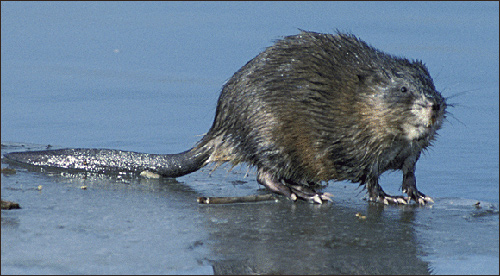Muskrats are common in Connecticut. They have dark brown fur and a 7 to 12 inch dark, hairless tail. The tail is slightly flattened but is not nearly as flat and broad as a beaver's, and is more rat-like in appearance. They are rodents and have prominent incisors that are brownish orange. Their hind feet are partially webbed for swimming. Although their appearance is similar, muskrats are much smaller than beavers, weighing only 1 to 4 lbs.
Common muskrats range through Alaska, Canada, and most of the continental US except for the most southern areas. These mammals are semi-aquatic and live in marshes, streams, rivers, lakes and shallow ponds. They prefer to build homes in shallower water of a few feet in depth unlike beavers who like deeper ponds. Muskrats are most active at dawn, dusk and night but can also be seen during the day. Muskrats are active year-round but if their pond freezes over, they stay under water or inside their houses. They don't store food, but forage vegetation through the winter and will sometimes feed from winter food stockpiles gathered by beavers.
Typical diet in the wild consists of aquatic plants. Cattails, rushes and water-lilies are favorites. They have been known to eat freshwater crustaceans, frogs and some fish at times. In the winter they may use the walls of their house as a food source.
Muskrats mate in late winter through early September and produce 1 to 5 litters a year consisting of 1 to 4 young per litter. A muskrat pair will be monogamous through the breeding season.
Muskrats do not build dams to create ponds as beavers do. Dens may be dug in the banks or a small house, resembling a smaller version of the beaver lodge, is built from vegetation such as cattails, rushes and small branches. Entrances and exits to the house are underwater, but the living chamber is built above the waterline. Muskrats may also build platforms, sometimes with roofs, for a sheltered place to feed. During periods of ice cover, muskrats may cut a hole in the ice and push pieces of vegetation through from the bottom of the pond. When the pile gets a foot or more high, the muskrat forms a hollow inside on top of the ice. This gives them a good winter place to take a breath or to eat foraged food.
Swimming muskrats can close their ears and nose to keep out the water. Like a beaver, the muskrat's lips are located behind its large incisors. The lips seal off the mouth so the muskrat can use its front teeth or chew with its inner teeth without any water going down its throat. While swimming, a muskrat's non-webbed forepaws are held as fists against its chest. The tail acts as a rudder, and can also be slapped against the water as a warning or alarm signal the way beavers slap their broad, flat tails. Muskrats can swim backwards and can remain underwater for 15 to 20 minutes. They get their name from a pair of scent glands near the tail that produce a strong-smelling musk, which is used to mark territory.
Muskrats are still trapped in Connecticut for fur although the trapping season is regulated. Trappers must pass a state course on trapping. Only two to four thousand animals have been taken annually in recent years. Twenty years ago as many as twenty thousand animals were trapped annually.
Neat Facts
Among muskrats, it is the female who goes advertising for a mate. She will swim around calling in a mouse-like squeak to attract a male.
Muskrats have been observed sharing beaver lodges with beavers over the winter.

